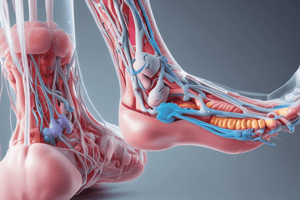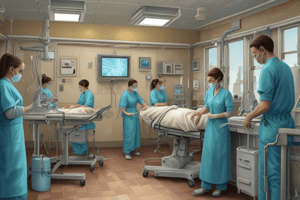Podcast
Questions and Answers
What is the minimum predicted postoperative FEV1 required for a patient to undergo an anatomic pulmonary lobectomy if their pre-operative FEV1 is less than 60%?
What is the minimum predicted postoperative FEV1 required for a patient to undergo an anatomic pulmonary lobectomy if their pre-operative FEV1 is less than 60%?
- ≥ 60%
- 35–40% (correct)
- ≥ 45%
- ≥ 50%
What is the recommended endoscopic surveillance interval for Barrett's esophagitis without dysplasia?
What is the recommended endoscopic surveillance interval for Barrett's esophagitis without dysplasia?
- Every 1 to 2 years
- Annual surveillance is recommended
- Every 6 months
- Every 3 to 5 years (correct)
When is an esophagectomy indicated for esophageal adenocarcinoma?
When is an esophagectomy indicated for esophageal adenocarcinoma?
- Only for lesions invading the muscularis propria (cT2N0) with high-risk features
- For all resectable lesions
- Only for lesions limited to the mucosa (cT1aN0)
- For resectable lesions that invade the muscularis propria (cT2N0) in the absence of high-risk features (correct)
Which of the following is NOT a condition associated with Epstein-Barr virus infection?
Which of the following is NOT a condition associated with Epstein-Barr virus infection?
What is the normal LES pressure with a food bolus?
What is the normal LES pressure with a food bolus?
What is the primary indication for splenectomy in the context of a multiloculated splenic abscess?
What is the primary indication for splenectomy in the context of a multiloculated splenic abscess?
What is the most likely causative organism for an encapsulated bacterial infection following splenectomy?
What is the most likely causative organism for an encapsulated bacterial infection following splenectomy?
Which of the following anatomical structures contains the splenic vessels and tail of the pancreas?
Which of the following anatomical structures contains the splenic vessels and tail of the pancreas?
Which of the following is NOT a risk factor for developing a pyogenic liver abscess?
Which of the following is NOT a risk factor for developing a pyogenic liver abscess?
Which of the following is NOT a surgical option for persistent anal fissures?
Which of the following is NOT a surgical option for persistent anal fissures?
What is the preferred surgical technique for live donor liver resection for pediatric transplantation?
What is the preferred surgical technique for live donor liver resection for pediatric transplantation?
Which of the following conditions would necessitate a right hemicolectomy for an appendiceal neuroendocrine tumor?
Which of the following conditions would necessitate a right hemicolectomy for an appendiceal neuroendocrine tumor?
Which of the following is a common side effect of octreotide treatment?
Which of the following is a common side effect of octreotide treatment?
Which of the following is NOT a common modality used for the localization of pancreatic neuroendocrine tumors (pNETs)?
Which of the following is NOT a common modality used for the localization of pancreatic neuroendocrine tumors (pNETs)?
What is the most common cause of portal hypertension with thrombocytopenia?
What is the most common cause of portal hypertension with thrombocytopenia?
Which of the following statements is TRUE regarding treatment of variceal bleeding?
Which of the following statements is TRUE regarding treatment of variceal bleeding?
What is the recommended treatment for a patient with variceal bleeding who has signs of hepatic encephalopathy?
What is the recommended treatment for a patient with variceal bleeding who has signs of hepatic encephalopathy?
What is the most common cause of liver cysts in the Middle East?
What is the most common cause of liver cysts in the Middle East?
Which condition is NOT indicated for stress ulcer prophylaxis with proton pump inhibitors?
Which condition is NOT indicated for stress ulcer prophylaxis with proton pump inhibitors?
What type of anemia is likely to occur post-RYGBP due to iron deficiency?
What type of anemia is likely to occur post-RYGBP due to iron deficiency?
Which of the following statements about GISTs is true?
Which of the following statements about GISTs is true?
Which of the following conditions specifically indicates the use of neoadjuvant chemotherapy?
Which of the following conditions specifically indicates the use of neoadjuvant chemotherapy?
A patient shows symptoms of neuromuscular issues after gastric surgery, indicating possible hypocalcemia. This is most likely due to:
A patient shows symptoms of neuromuscular issues after gastric surgery, indicating possible hypocalcemia. This is most likely due to:
What is the most significant indicator for malignant potential in a GIST?
What is the most significant indicator for malignant potential in a GIST?
What procedure should be performed if a large ulcer is found along the greater curvature of the stomach?
What procedure should be performed if a large ulcer is found along the greater curvature of the stomach?
What is the expected time frame for gastric motility to return post abdominal surgery?
What is the expected time frame for gastric motility to return post abdominal surgery?
What is the best method for diagnosing proximal small bowel lesions?
What is the best method for diagnosing proximal small bowel lesions?
What is the recommended treatment for a broad-based Meckel diverticulum during an appendectomy on a child?
What is the recommended treatment for a broad-based Meckel diverticulum during an appendectomy on a child?
What is the best management strategy for post-operative ileus?
What is the best management strategy for post-operative ileus?
What type of lymphoma is associated with celiac disease?
What type of lymphoma is associated with celiac disease?
What should be done during an EGD for large ulcers regardless of their location?
What should be done during an EGD for large ulcers regardless of their location?
For a patient with intrahepatic cholangiocarcinoma without metastatic disease, what is the preferred treatment option?
For a patient with intrahepatic cholangiocarcinoma without metastatic disease, what is the preferred treatment option?
What is a contraindication for the resection of paracellular carcinoma?
What is a contraindication for the resection of paracellular carcinoma?
Which of the following is the most frequent serious complication following pancreaticoduodenectomy?
Which of the following is the most frequent serious complication following pancreaticoduodenectomy?
What is the recommended approach to use during necrotizing pancreatitis to minimize operative interventions?
What is the recommended approach to use during necrotizing pancreatitis to minimize operative interventions?
Which finding strongly suggests a pyogenic liver abscess on CT imaging?
Which finding strongly suggests a pyogenic liver abscess on CT imaging?
What is the approximate central venous pressure that should be targeted during liver transection to minimize bleeding?
What is the approximate central venous pressure that should be targeted during liver transection to minimize bleeding?
Which type of drainage is recommended for fungal hepatic abscesses?
Which type of drainage is recommended for fungal hepatic abscesses?
What is the expected functional liver remnant percentage after resection for a patient with cirrhosis?
What is the expected functional liver remnant percentage after resection for a patient with cirrhosis?
Flashcards
Barrett's Esophagus Surveillance
Barrett's Esophagus Surveillance
Barrett's esophagus without dysplasia requires endoscopic surveillance every 3-5 years. Don't do it every six months!
LES Pressure
LES Pressure
The lower esophageal sphincter (LES) should have a pressure of 10mmHg when relaxed and 0mmHg when a food bolus is present.
Hiatal Hernia Repair Length
Hiatal Hernia Repair Length
A minimum of 2-3 cm of intra-abdominal esophagus is needed for hiatal hernia repair.
Collis Gastroplasty
Collis Gastroplasty
Signup and view all the flashcards
Pulmonary Lobectomy FEV1
Pulmonary Lobectomy FEV1
Signup and view all the flashcards
Post RYGBP Microcytic Anemia
Post RYGBP Microcytic Anemia
Signup and view all the flashcards
Gastrointestinal Stromal Tumor (GIST)
Gastrointestinal Stromal Tumor (GIST)
Signup and view all the flashcards
Afferent Loop Syndrome
Afferent Loop Syndrome
Signup and view all the flashcards
Stress Ulcer Prophylaxis Indications
Stress Ulcer Prophylaxis Indications
Signup and view all the flashcards
Early Gastric Cancer Management
Early Gastric Cancer Management
Signup and view all the flashcards
GIST hallmark
GIST hallmark
Signup and view all the flashcards
Gastroepiploic artery preservation
Gastroepiploic artery preservation
Signup and view all the flashcards
Stomach ulcer biopsy
Stomach ulcer biopsy
Signup and view all the flashcards
Stomach fluid secretion
Stomach fluid secretion
Signup and view all the flashcards
Malignant GIST indicators
Malignant GIST indicators
Signup and view all the flashcards
Post-op ileus treatment
Post-op ileus treatment
Signup and view all the flashcards
Return of bowel function
Return of bowel function
Signup and view all the flashcards
Celiac disease and T-cell lymphoma
Celiac disease and T-cell lymphoma
Signup and view all the flashcards
Neuroendocrine Tumor (NET)
Neuroendocrine Tumor (NET)
Signup and view all the flashcards
Chromogranin A
Chromogranin A
Signup and view all the flashcards
Pancreastatin
Pancreastatin
Signup and view all the flashcards
Cholelithiasis (Gallstones)
Cholelithiasis (Gallstones)
Signup and view all the flashcards
Angiography with arterial stimulation and portal venous sampling
Angiography with arterial stimulation and portal venous sampling
Signup and view all the flashcards
Echinococcus multilocularis
Echinococcus multilocularis
Signup and view all the flashcards
Hepatitis C
Hepatitis C
Signup and view all the flashcards
Transjugular Intrahepatic Portosystemic Shunt (TIPS)
Transjugular Intrahepatic Portosystemic Shunt (TIPS)
Signup and view all the flashcards
What are the key stimulators of pancreatic secretions?
What are the key stimulators of pancreatic secretions?
Signup and view all the flashcards
How does secretin secretion get triggered?
How does secretin secretion get triggered?
Signup and view all the flashcards
How are splenic abscesses treated?
How are splenic abscesses treated?
Signup and view all the flashcards
When is a right hemicolectomy indicated for appendiceal neuroendocrine tumors?
When is a right hemicolectomy indicated for appendiceal neuroendocrine tumors?
Signup and view all the flashcards
What is the surgical treatment for persistent anal fissures?
What is the surgical treatment for persistent anal fissures?
Signup and view all the flashcards
Intrahepatic Cholangiocarcinoma: Resection Eligibility
Intrahepatic Cholangiocarcinoma: Resection Eligibility
Signup and view all the flashcards
Liver Biopsy: Colorectal Cancer Metastasis
Liver Biopsy: Colorectal Cancer Metastasis
Signup and view all the flashcards
Gallstone Formation: Nucleation of Sterol Monohydrate
Gallstone Formation: Nucleation of Sterol Monohydrate
Signup and view all the flashcards
CT: Pyogenic Liver Abscess
CT: Pyogenic Liver Abscess
Signup and view all the flashcards
Paracellular Carcinoma: Resection Contraindication
Paracellular Carcinoma: Resection Contraindication
Signup and view all the flashcards
AML: Risk Factor for Acalculous Cholecystitis
AML: Risk Factor for Acalculous Cholecystitis
Signup and view all the flashcards
Fungal Liver Abscess: Treatment
Fungal Liver Abscess: Treatment
Signup and view all the flashcards
Necrotizing Pancreatitis: Management
Necrotizing Pancreatitis: Management
Signup and view all the flashcards
Study Notes
Nutrition & Metabolism
- Enteral nutrition is preferred over parenteral nutrition within 24-48 hours in critically ill patients.
- Tube feeding can be initiated in critically ill patients expected to have mechanical ventilation for at least 72 hours.
- Respiratory quotient (RQ) of 1.0 = carbohydrates
- RQ of 0.7 = lipids
- Kwashiorkor is a condition where kids have fatty liver due to decreased carrier protein synthesis, which is a result of the lack of amino acid availability, making it difficult to transport lipoproteins out of the liver. Kwashiorkor is more severe than marasmus
- Copper deficiency can manifest as pancytopenia, neuropathy, and ataxia, often seen after TPN without trace minerals or following a gastric bypass.
- Selenium deficiency is linked to cardiomyopathy, hypothyroidism, and neurological changes.
- Calcium chloride has a higher concentration of elemental calcium than calcium gluconate, but it's caustic when administered peripherally. It's usually reserved for code situations.
- Prealbumin has a half-life of 48 hours, while albumin's half-life is 21 days.
- 25-30 kcal/kg/day = Basal Energy Expenditure (BEE) for a well-nourished patient undergoing mild stress surgery.
- 300 kcal/day increase for pregnancy, 500 for lactation
Short Chain Fatty Acids
- Short chain fatty acids are absorbed by simple diffusion.
- Long chain fatty acids are absorbed by micelles.
- Short chain fatty acids are used as substrates for colonocyte nutrition.
- Short chain fatty acids are produced in the colon via the action of bacteria on undigested carbohydrates.
- Patients with colostomies or distal rectal pouches may develop diversion colitis due to lack of short chain fatty acids, which nourish the mucosa.
Preoperative Nutrition Assessment
- Preoperative nutritional support should consider albumin and vitamin D levels.
- Albumin < 3 or vitamin D < 20 are qualifiers for nutritional support.
Head & Neck
- Surgical excision of the remnant is the management for branchial cleft anomalies in children.
Salivary Duct Carcinoma
- Salivary Duct carcinoma is similar to high-grade breast carcinoma.
- Salivary Duct carcinoma is responsive to hormonal therapy.
- Warthin tumors are common, often associated with smoking. They have a rare malignant potential and can be bilateral or multicentric.
- Adenoid cystic carcinoma tends to have a slow onset and distant metastases.
Endocrine
- The best surgical treatment for hyperparathyroidism in MEN1 patients is a 3.5-gland or 4-gland resection with autotransplantation and cervical thymectomy.
- The optimal surgical approach for hyperparathyroidism in MEN1 is either a 3.5-gland or 4-gland resection with autoimplantation.
- This should be accompanied by a prophylactic transcervical thymectomy to reduce the risk of thymic carcinoid tumors.
Imaging
- Imaging like ultrasound, 4D CT, and sestamibi are used for surgical planning, but they do not impact diagnosis of primary hyperparathyroidism.
DCIS/LCIS and Breast Cancer
- Invasive lobular carcinoma is less inflammatory and commonly presents as a soft mass.
- Imaging can underestimate the size of the tumor.
Esophagus
- Superficial mucosal injuries (grade 1 & 2) in hemodynamically stable patients can be observed.
Zargar Classification of Esophageal Injuries
- Don't use barium if esophageal perforation is suspected; use Gastrografin instead.
- The swallowing center is located in the medulla, not the pons.
- Barrett esophagitis without dysplasia requires endoscopic surveillance every 3-5 years, not every 6 months.
- Normal lower esophageal sphincter (LES) pressure is 10mmHg; with food bolus, it should be 0mmHg.
Chyle Leaks
- Low-volume (<1.5 L/day) chyle leaks can often be managed conservatively with a low-fat diet, somatostatin analogs, and drainage.
- If conservative management fails, total parenteral nutrition (TPN) may be considered.
Stomach
- Epstein-Barr virus is associated with nasopharyngeal cancer, Hodgkin disease, Burkitt lymphoma, gastric cancer, and lymphoproliferative disease in AIDS patients.
Gastric Tumors
- Gastrointestinal stromal tumors (GISTs) are most commonly found in the stomach (60%-70%), followed by the small bowel.
- GIST prognosis depends on tumor size and mitotic index.
Miscellaneous
- Kaposi's sarcoma is associated with HHV-8.
- Normal phi angle in gastric band surgery is 4-58 degrees.
- Stress ulcer prophylaxis with a proton pump inhibitor is indicated for patients with traumatic brain injury, spinal cord injury, mechanical ventilation for >48 hours, severe burns (>=20% BSA), or coagulopathy (INR > 1.5, PTT > 2x normal).
Studying That Suits You
Use AI to generate personalized quizzes and flashcards to suit your learning preferences.




